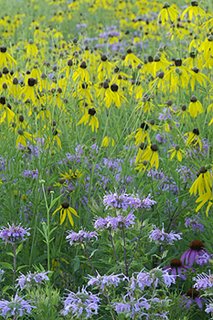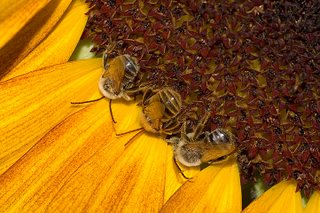
We have a two-acre meadow that was planted from seed in spring 2000 by Wildflower Farm. It's a mixture of North American prairie natives, both flowers and grasses. Why a meadow? As I said to my husband when we were in the planning stages: there is no way we're going to mow 10 acres.
The meadow required a good deal of patience. It took three years after sowing for the plants to get blooming. Of all the garden areas we have, I enjoy the meadow most because it attracts masses of birds and butterflies and it doesn't have to be weeded.
The wildflower meadow is at its most beautiful in July (as in the picture below), but there is a meadow plant that comes into its prime in late August into September: meadow blazingstar (Liatris ligulistylus), hardy to Zone 4.

Unlike the single flower spike of most blazingstars, meadow blazingstar is branched and has numerous individual flowers that bloom over four to six weeks. The plant grows three to five feet tall and thrives in rich, loamy soils.
In Canada, you can get seeds from Wildflower Farm or buy plants from them in spring. US sources include: Prairie Nursery and High Country Gardens.
To grow meadow blazingstar from seed, follow these instructions from Wildflower Farm:
Use cold, moist stratification. Mix seed with moist but not wet, sterile growing medium. Place mixture in a labeled, sealed plastic bag and store in refrigerator for six to eight weeks. Note: Some seed may germinate in the storage bag if moist stratified too long. If sprouting occurs, plant immediately. Another method is to sow seed outdoors in late autumn so that they may overwinter.More wildflower meadow information is here.


